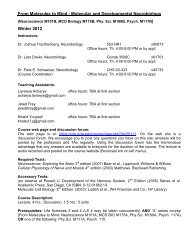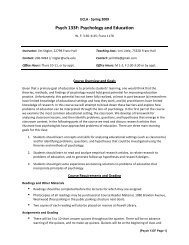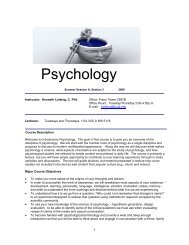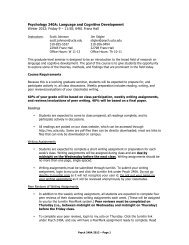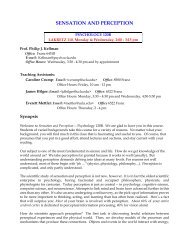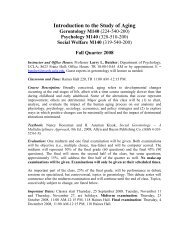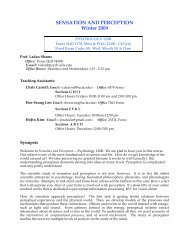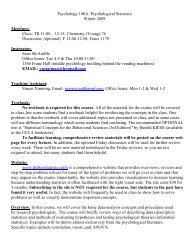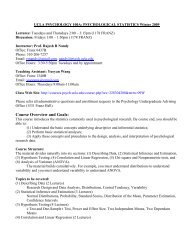PSYCHOLOGY 134A/D: Applied Developmental Psychology
PSYCHOLOGY 134A/D: Applied Developmental Psychology
PSYCHOLOGY 134A/D: Applied Developmental Psychology
Create successful ePaper yourself
Turn your PDF publications into a flip-book with our unique Google optimized e-Paper software.
<strong>PSYCHOLOGY</strong> <strong>134A</strong>/D: <strong>Applied</strong> <strong>Developmental</strong> <strong>Psychology</strong>Overview<strong>Psychology</strong> <strong>134A</strong> looks at developmental psychology in the applied context of early childhood education.Early childhood education is generally defined as the period from birth through 8 years of age.<strong>Psychology</strong> <strong>134A</strong> will address the approximate period of 0 - 3 years of age.Topics covered will be physical, cognitive, social, and emotional development; developmentallyappropriate practice; child care quality; the role of the educator/caregiver; and other related issues. Thecourse consists of a lecture and a discussion section (letter grading).Instructor Laura Rose MPHlrose@psych.ucla.eduOffice hours by appointment`Teaching Assistant - Mariel Kygermarielkyger@ucla.eduOffice Hours -TextsBredekamp and Copple ed. <strong>Developmental</strong>ly Appropriate Practice in Early Childhood Programs -Revised. NAEYC.Additional readings will be handed out in class or on Blackboard.Janet Gonzalez-Mena & Dianne W. Eyer. (2004) Infants, Toddlers, and Caregivers: A Curriculum ofRespectful, Responsive Care and Education (7h Edition). New York, NY: McGraw-Hill Companies, Inc.Lecture:Mondays & Wednesday 2:15 – 4:15Class Location – Franz 3435RequirementsClass meetings consist of lecture and discussion. Students are expected to attend class and participate indiscussions. There are assigned readings to be completed prior to class meetings. There are assignmentsto be turned in by the due date.There will be a midterm project and a final exam. The midterm project consists of a short (5 – 7 page)paper and a participation in a discussion. The cumulative final exam consists of multiple choice items,short answer items, and short essay questions.Grading<strong>Psychology</strong> <strong>134A</strong> is only offered on a letter-grade basis and must be taken in conjunction with<strong>Psychology</strong> 134D. Students must receive a C- or better in <strong>134A</strong> and a pass grade in 134D (requiredfieldwork), as well as complete all required assignments, in order to receive credit for <strong>134A</strong>.10% Attendance & Participation30% Weekly journal assignments (15% for child observation and 15% for reflective journals30% Midterm project30% Final exam1
“Widening Our Lens” - Assignment Description - 30 pts.In order to build relationships with children, families and other staff, early childhood educators need to beable to articulate child development research while also embracing and encouraging an understanding ofculture and individual belief systems.Topic Statement ExamplesSleeping Practices Thumb-sucking and pacifiers Eating/Feeding PracticesImmunizations Television Toileting PracticesDiscipline Celebrating Holidays at Preschool Other topics?Midterm Paper and PresentationYou and your partner will be assigned a topic by the 2 nd week of class. Working with your partner, youwill need to develop a presentation approach which allows examination of the topic from differing pointsof view.Suggested Research Resources and ReferencesCitations must come from peer-research journals or text. Citations must not be from theWikapedia or from the popular press (e.g.,magazines found in bookstores). Please utilizejournals such as:§ Child Development§ Young Children§ Journal of Research in Childhood Education§ Childhood Education§ Early Education and Development§ Early Child Development and Care§ Child Study Journal§ Early Childhood Research Quarterly§ Journal of Early Intervention§ <strong>Developmental</strong> <strong>Psychology</strong>§ Review of Research in Education§ Family Relations§ Journal of Social PolicyClass TextsGonzalez-Mena – Chapter 14 – Entire Chapter and then the end sections of Chapters 2, 3 and 4DAP – Statement of Position pp. 8 – 52 DAP: Part 1 and Part 2OnlineNational Association for the Education of Young Children – www.naeyc.orgProgram for Infant Toddler Caregivers – www.pitc.orgZero to Three – www.zerotothree.org4
Written Paper (20 pts.)• Content4-5 citations – 1 citation should be an interview with a caregiver and/or parentProvides analysis and application of researchThesis statement is supported throughout the paperNumber of points made (average 4)Discussion and articulation of points• Writing MechanicsFlow/Coherence/OrganizationUse of headings/subheadingsClarityGrammarEvidence of proof-readingCitations in APA StylePresentation Guidelines (10 pts)Students will be grouped and present according topics. Presentations should be a 15 minutes;summarizing the topic and an examination of the topic from differing points of view.5
Early Childhood Education Paper and Presentation Rubric and Self – EvaluationScale Poor 1 Fair 2 Good 3 - 4 Superior 5 Pts.Written PaperStrong, clear thesis x210 pts.Unclear/nothesis.Inappropriatecitations.No first draftpapersubmitted.Unfocused thesis.Little inclusion ofevidence to supportclaims.Underdevelopmentand/or repetition ofideas.First draft papersubmitted late.1-2 citations – APAstyleClear thesisInclusion of evidencethat may be underanalyzed.Brief development ofideas.First draft papersubmitted on time.2-3 citations - APAstyleEffective use ofevidence that isanalyzed notmerely presented.Lucid developmentof ideas.Logical structure.4-5 citations APAstyle adhered.WritingConventions10Presentation10Beginning draft.LacksorganizationMisspellingsIncorrectgrammarHandwrittencorrectionsNot preparedUnclearDisorganized.First draft quality –errors hinderreadability.Needs paragraphs.Long/incompletesentencesProper grammarAccurate word useEvidence of proofreadingMisspellingsTopic and positionstated.No or few examples.Disorganization ofideas.Difficult to understand.Reads from paper.LateWell organizedTyped & doublespaced.Needs paragraphs.Correct spellingFew minorgrammatical errors.Accurate word useEvidence of proofreadingNo misspellingsTopic and positionclearly stated andsupported withexamples.Logical structurebeginning to end.Prepared but somedisorganization.Speaks loudly andclearlyAdheres to time-limit.Well organizedTyped & doublespaced.Appropriate use ofparagraphs.Correct spellingFew minorgrammatical errors.Accurate word useEvidence of proofreadingNo misspellingsTopic and positionclearly stated andsupported withexamples.Logical structurebeginning to endWell-prepared -Presents ratherthan readsmaterial.Speaks loudly andclearlyAdheres to timelimit.x2x2Self-Evaluation Comments6



